Projects
the Intersection
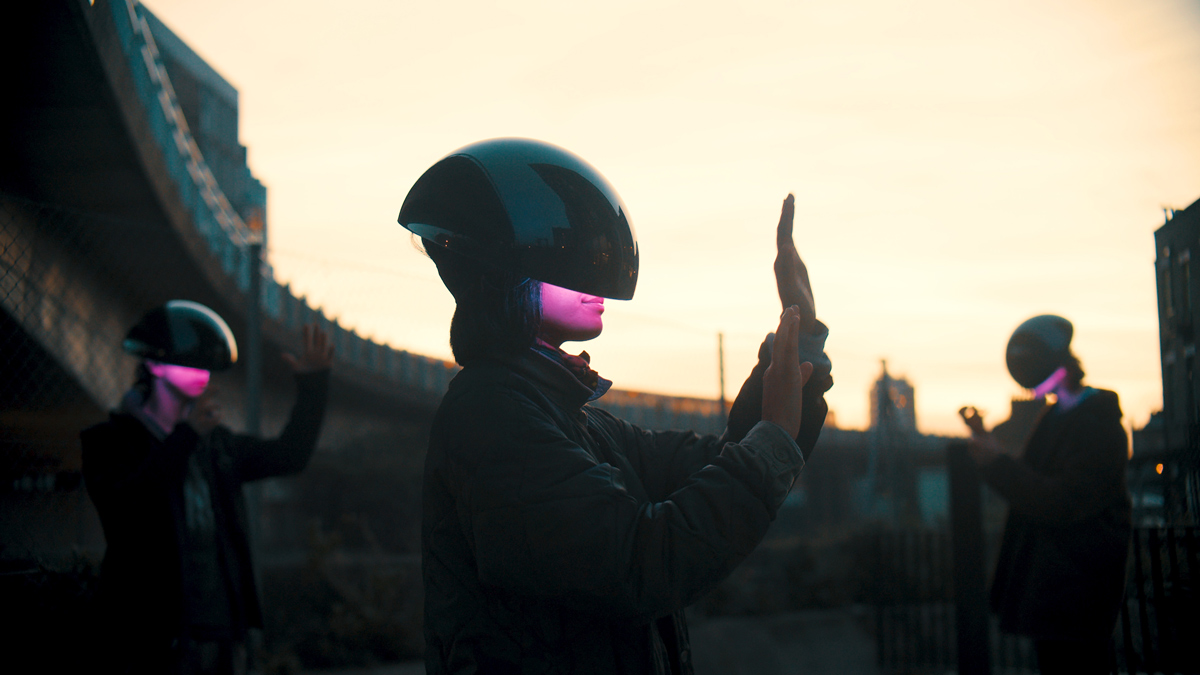 Set in the near future, our film the Intersection journeys from a violent present to a cooperative future.
Set in the near future, our film the Intersection journeys from a violent present to a cooperative future.
Telling stories of active hope from those who have fought to reimagine extractive technology, to serve community, support nature, and value planetary relationships.
This film and accompanying critical foresight, research and speculative design project is commissioned by Eshanthi Ranasinghe, Julia Solano and Nicole Allred, Explorations & Future Sensing, Omidyar Network, and is conceived and produced by Superflux 2021.
OUR MULTI PRONGED RESEARCH AND FORESIGHT PROCESS
Who we are, how we act, what we gather around, our collective agency, our hopeful futures; they are all deeply entangled with messy histories of extractive capitalism, exacerbating tragedies of colonialism, racial injustice, social inequality and climate apathy.
Present-day ambient technologies: Ingestibles, wearables, embeddables; smart homes and peer-to-peer surveillance; the Internet of Things (IoT) and Industrial IoT; 5G; smart cities; facial recognition, temperature checking pandemic drones, and satellite imagery, are built on such exploitative histories, further amplifying inequality and injustice. The encompassing and interconnected nature of such ever-present, always-on technology – means that we are barreling towards a society in which every single interaction with the physical and digital world is fair game for extraction and exploitation. If we want to help build better, regenerative, democratic futures, this must change.
We were invited by Omidyar Network to provoke imagination about futures evolved collectively from reckoning our relationship with technology. Together, how could we build the infrastructure, protocols, norms, social structures, and policies for a technology ecosystem that can empower all? As always, we adopted a multi-pronged approach to researching the themes posed by the brief, from wide-spanning foresight and ethnographic research, speculation, worldbuilding and storytelling.
Ethnographic and Foresight Research
We carried out an intensive period of ethnographic research led by Superflux collaborator Yuebai Liu to learn about the hopes and fears of people who are often disenfranchised from technological developments. Kicked off during the first covid lockdown, we worked with available digital channels, encouraging the use of mobile diaries and text based digital communication. Key insights include the themes of emotional labour and its messy relationship with privacy, fear of technological alienation, how lack of agency leading to disillusionment, negotiation of personal liberties in order to return to ‘normality’ and more.
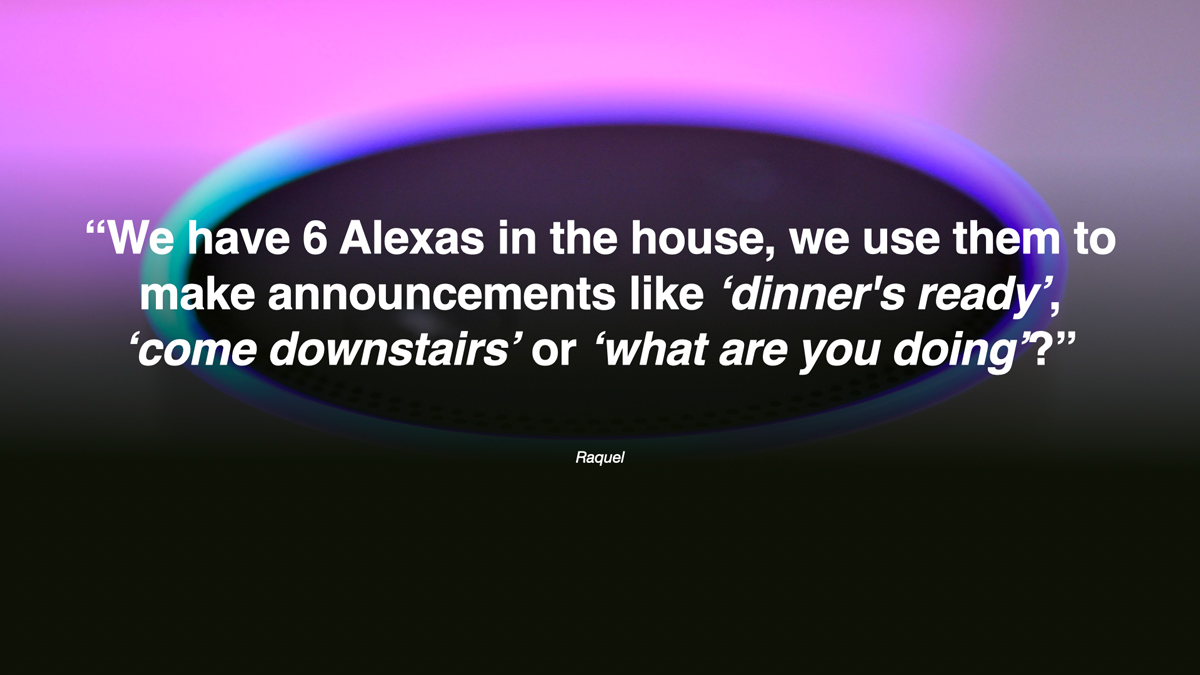
Running in parallel to our ethnographic research, Superflux collaborator Aarathi Krishnan led an initial foresight study focusing on the impact of emerging ambient technologies on marginalised communities.
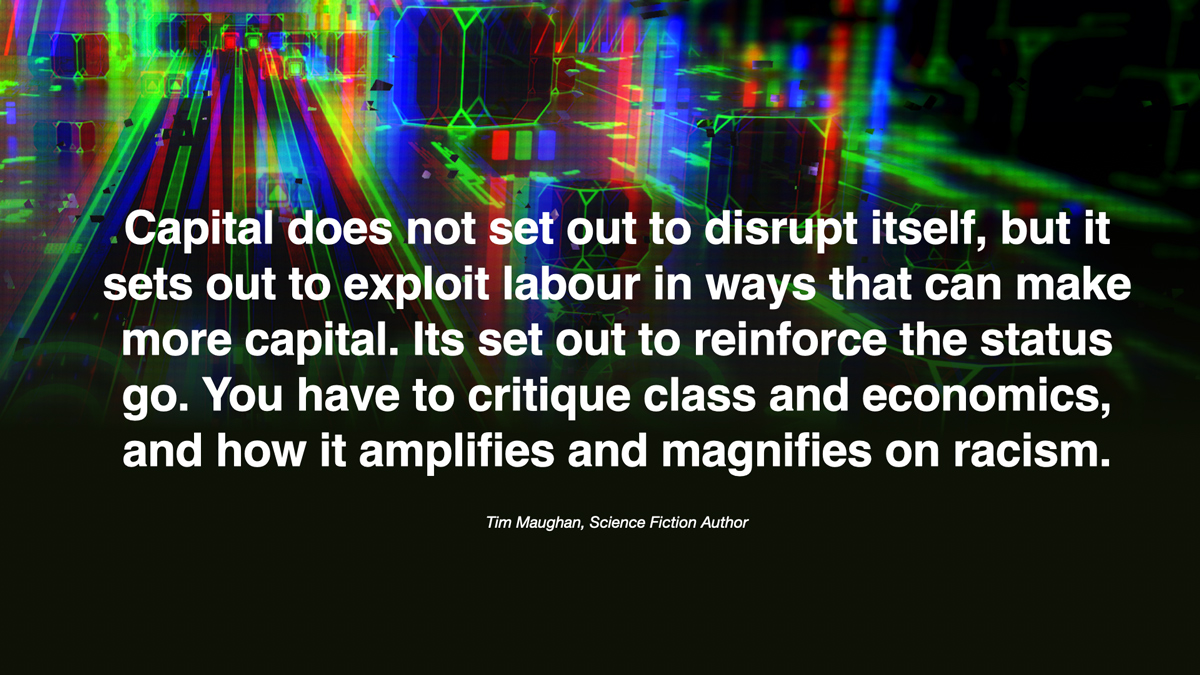
Following a series of insights workshops, we cast a broader net with our long-time collaborators Jay Owens and Justin Pickard to seek out deeply entangled forces at play within technology, governance, civic infrastructure, culture and politics. Through this deep research and frantic writing, emerged an expansive 108-page foresight and sensemaking report, as well as an executive summary, for use in internal strategy and visioning work.
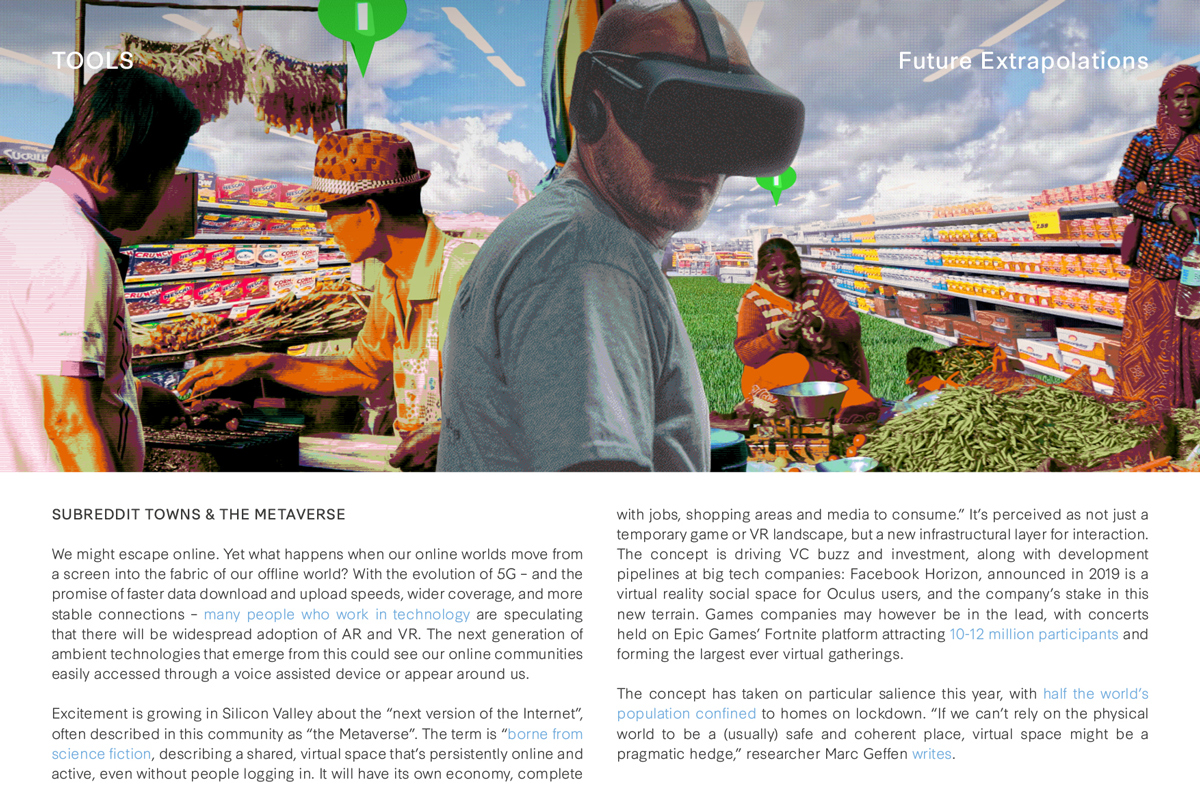
Critical Sensemaking
We want to take a moment here to reflect on what is perhaps the most important part of such work: critical sensemaking. Our practice bridges research, foresight, speculative design, embodied experiences, narrative and imagination. It is critical that we remain open and generative in translating observational research into analytic and intuitive insights, which then surfaces a possibility space, leading us to more defined outcomes and deliverables; whether that is strategy, prototypes, simulations, interactive experiences, narratives or reports.
Scenario Pathways
The widely-used four-quadrant scenario planning method is often used as a means of generating future scenarios from foresight research. Whilst we see such methods as agile tools, we at Superflux found value in combining, building up and creating complex worlds with, interdependencies, winners and losers, rather than breaking down into smaller scenarios.
We launched into this work as the UK and many other parts of the world plunged into lockdown, furiously adapting and always open to emergent possibilities. The seeming stillness enforced by the pandemic pronounced the convergence of cataclysmic dispatches from around the world: the devastating wildfires in Australia, California, and the Pacific NorthWest, the unjust murders of George Floyd and Breonna Taylor and the ensuing light cast on every crevice of an expired system. And, ultimately, the inescapable anger.
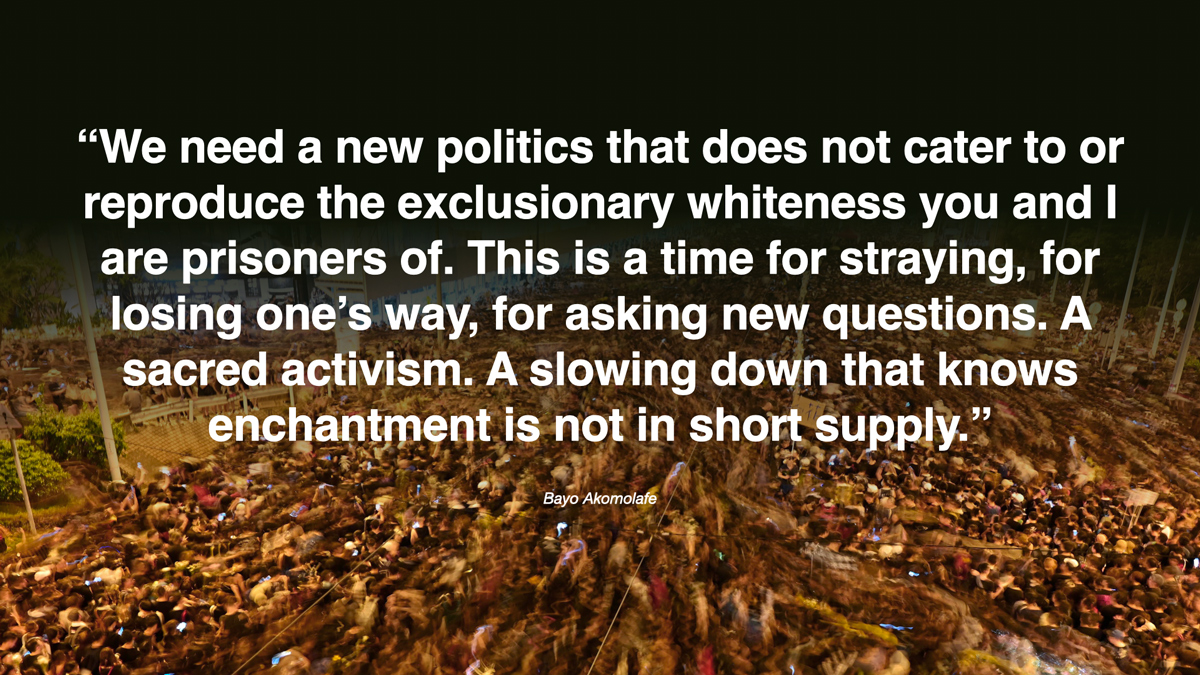
WORLDBUILDING, SPECULATIVE DESIGN AND STORYTELLING
Our concept development work centred the following:
- Question concentration of power and explore redistribution of power,
- Investigate and challenge current economic models,
- Explore alternate business models for ambient technology,
- Embed pluralism,
- Inclusive tech; amplify the voices of marginalised people,
- Imagine hopeful visions
Our concept work further investigated how to give narrative and visceral form to ideas of ambient technology interwoven not just in social and civic life but also how it perpetuated racial injustice, and how extractive capitalism exacerbated this further.
To ensure that this work was pluralistic from the beginning, alongside workshops, interviews and participatory activities we invited three people to become Advocates in our journey – people with inspiring lived experiences in activism, advocacy, ambient technology mutual aid and community support. This journey was especially critical as one of our advocates found themselves having to flee their own home because of a wildfire. A stark reminder of the interconnected nature of the challenges we face – whether environmental, social or technological, these domains don’t reside within neat categories, they overlap and intermingle, and therefore must be addressed as such. Short circuiting complexity in favour of bite-sized simplicity is dangerous.
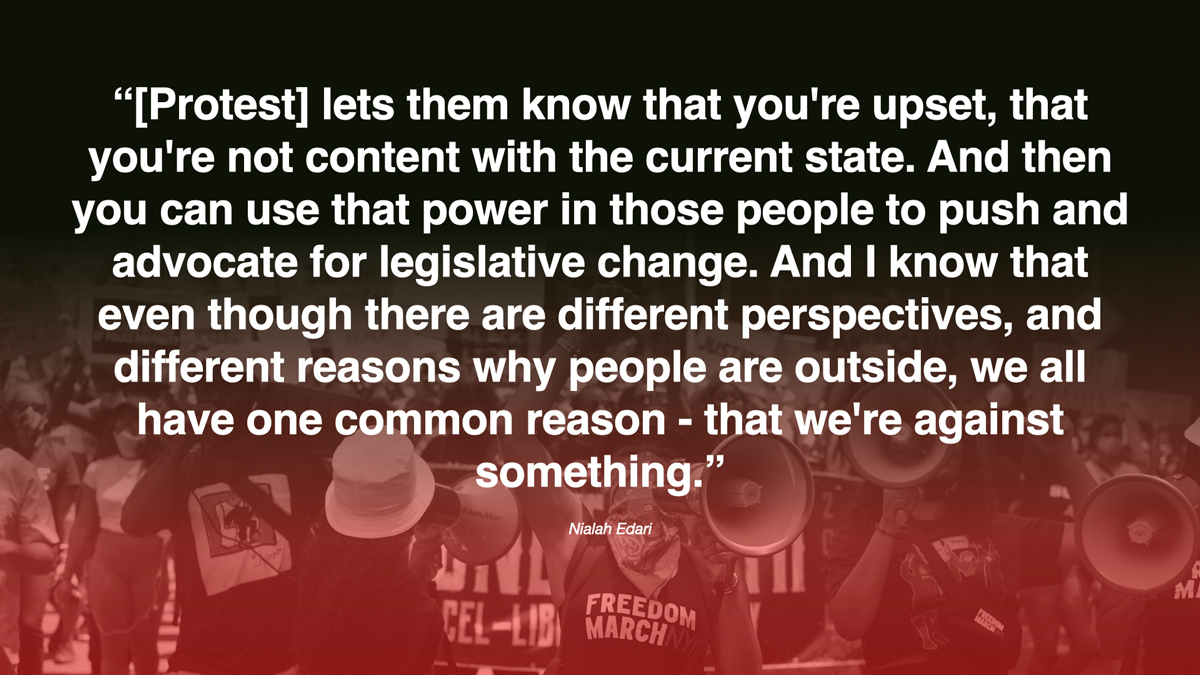 Quote from one of our Advocate, Nialah Edari, co-founder of Freedom March NYC
Quote from one of our Advocate, Nialah Edari, co-founder of Freedom March NYC
Inspired by our collective discussions and learning journey with our Advocates, we generated a set of emergent principles to develop concepts around, from which emerged a number of modest to wild propositions that were translated into texts, scenarios, vignettes, stories and sketches. For instance, transitional scenarios that move us from what feels like 24/7 DDOS attack on our will, to calls for a complete rejection of anything that hijacks our limbic system; from a state of near total corporate occupation to a radical financial and societal welfare model of distributed power and wealth; from climate events like the Ross ice shelf collapsing into the Southern Ocean and a massive methane release from the Siberian permafrost to the celebration of solarpunkesque manifestation of civic care, frugality and conviviality.
the Intersection
Our final concept is translated into a short film the Intersection situated within a possible hopeful future, several years after growing inequality and the splintering of reality reached a critical mass. Influenced by Ken Burns’s documentary ‘The Dust Bowl’, it features a diverse series of protagonists individually recounting their personal past experiences and their place in the emergence of the future they now live in — both the chaos and the hope that surfaced afterwards. Certain events and aspects of the larger world overlap, and are witnessed and described through more than one of our protagonists’ lenses, helping to build a rich, interconnected world and history. As we reach the final act of the film, more is revealed about the isolated individuals and where they are now, in the present, and how their journeys have changed – together.
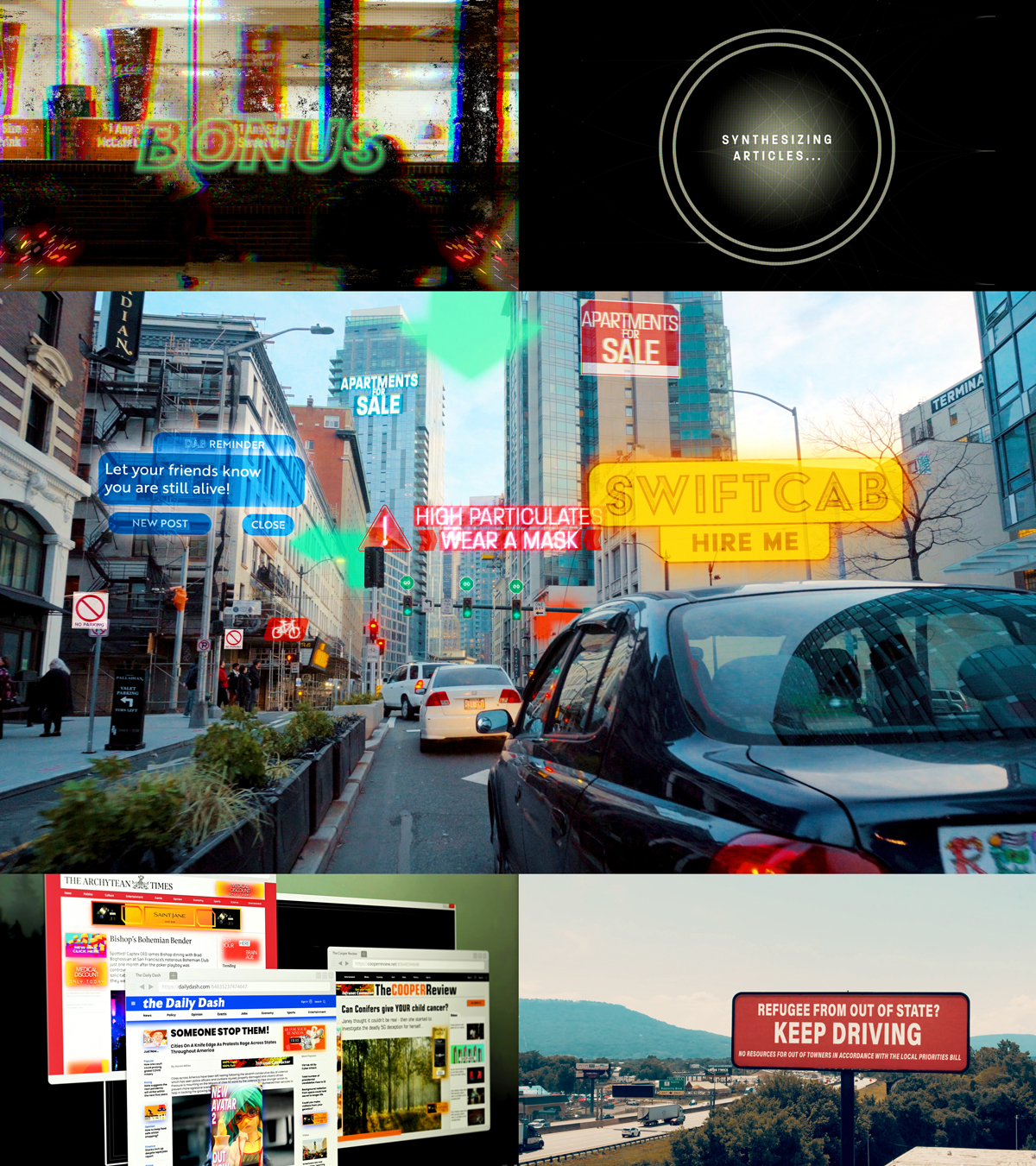 Stills from the film of the escalating chaos witnessed by the various characters
Stills from the film of the escalating chaos witnessed by the various characters
The narrative arc of the film revolves around four protagonists (pictured below) whose lives have been shaped by the dissonance of extractive technology norms, misinformation, surveillance capitalism, and context collapse:
Ericka a veteran activist whose movement for justice is derailed by a never-ending feed of misinformation and conspiracies concocted to extract data.
Jake, a journalist whose work is diluted and corrupted by AI systems that helped him prioritize clicks over the truth, taking news out of context and pandering to readers’ “intensely monitored, precisely categorized fears.”
Amp, a disillusioned hardware engineer who set out to change the world using technology, only to have their utopian dream shattered by the realization that the only problem they were solving was finding new ways for technology companies to make money.
Tammi, a young climate migrant who became a refugee in her own country because her family refused to evacuate in the face of an impending storm, citing “fake news” reports.
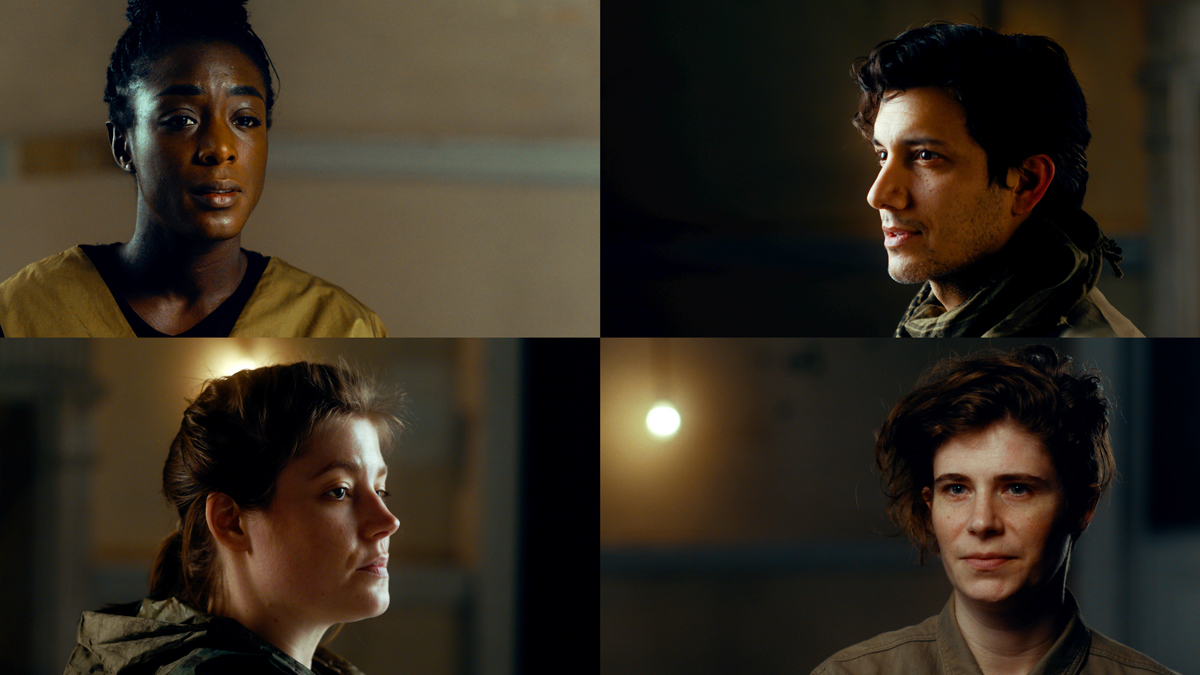 The four protagonists of the film
The four protagonists of the film
Design Artefacts
Key part of our work is to embed meaningful touchpoints or ‘diegetic prototypes’ situated in imagined future worlds that help draw attention to complex social, cultural, political and environmental relationships.
The design artefacts are reminiscent of what we at Superflux loosely call ‘The Craftocene’: Resurgent Tools Generated from the Waste of the Anthropocene. Our speculative artefacts propose alternate, craft manifestations of technology, a move back into smaller and tighter communities, emergent decentralized mesh networks, local wifi networks to warn of dangers in the local environment or damages in the network and celebrate the connections between technology and our natural worlds. Each artefact was handmade by materials that would be available in the future in which mass production has been limited, focusing on the re-use and repair of existing components and products to achieve the purposes of this new way of being.
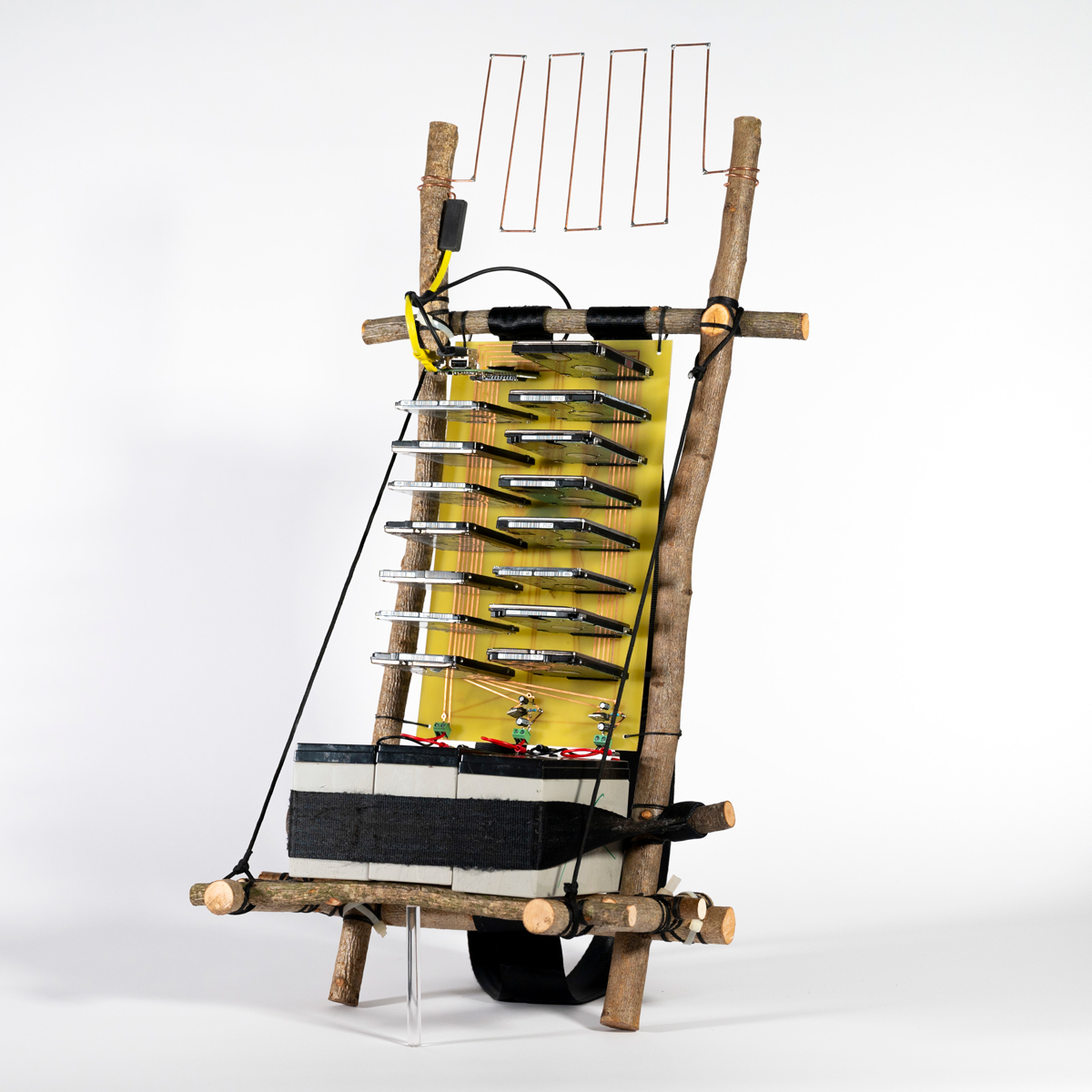 Server Pack Frame: A nomadic storage device for transporting and sharing data within a dispersed and decentralised network, influenced by centuries old traditional pack frame structures built using natural materials.
Server Pack Frame: A nomadic storage device for transporting and sharing data within a dispersed and decentralised network, influenced by centuries old traditional pack frame structures built using natural materials.
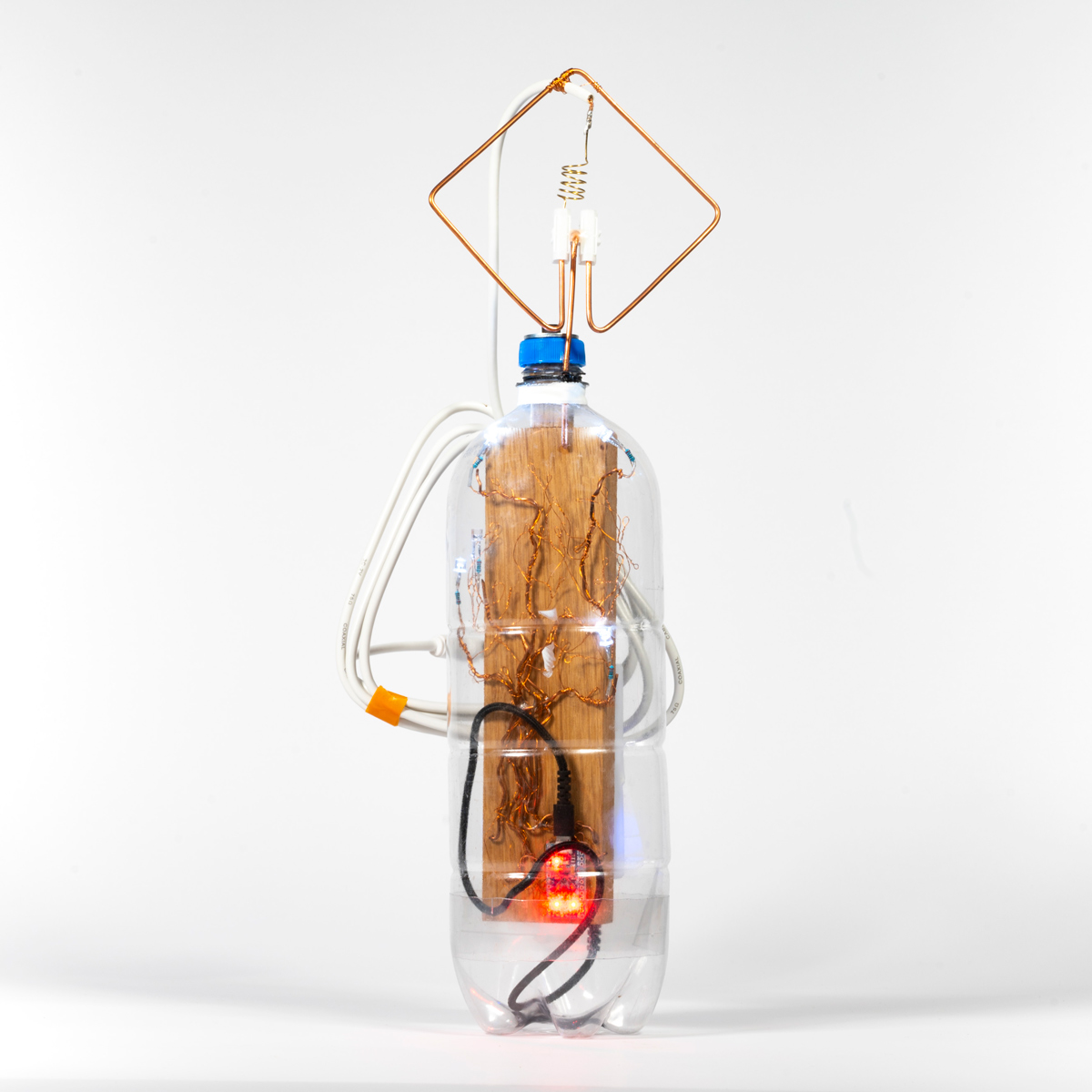
 Sensors: A series of hyper-local, mesh network sensing nodes constructed using readily available materials. These are distributed within an environment to collect data about the surroundings.
Sensors: A series of hyper-local, mesh network sensing nodes constructed using readily available materials. These are distributed within an environment to collect data about the surroundings.
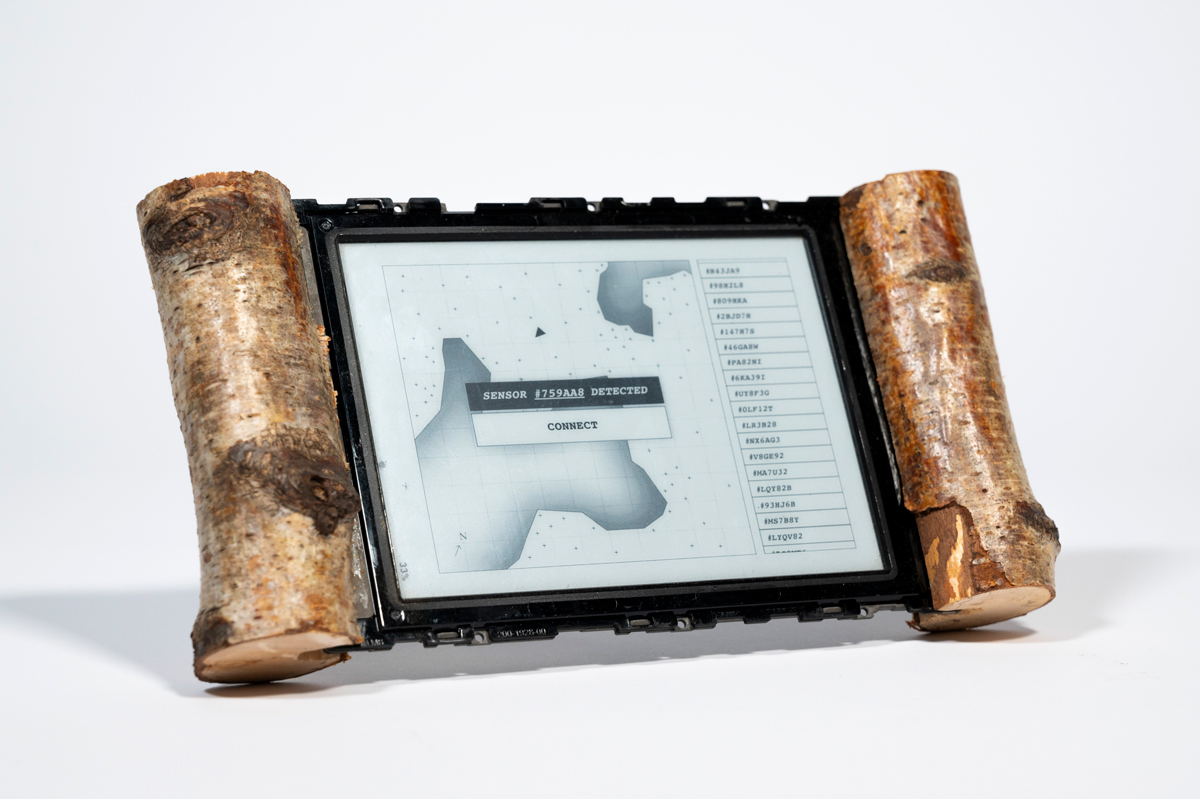 Sensor Network Monitor: An e-ink based device which gathers and visualises data collected by the distributed network of sensors, enabling a non-extractive monitoring of any fluctuations within an ecosystem.
Sensor Network Monitor: An e-ink based device which gathers and visualises data collected by the distributed network of sensors, enabling a non-extractive monitoring of any fluctuations within an ecosystem.
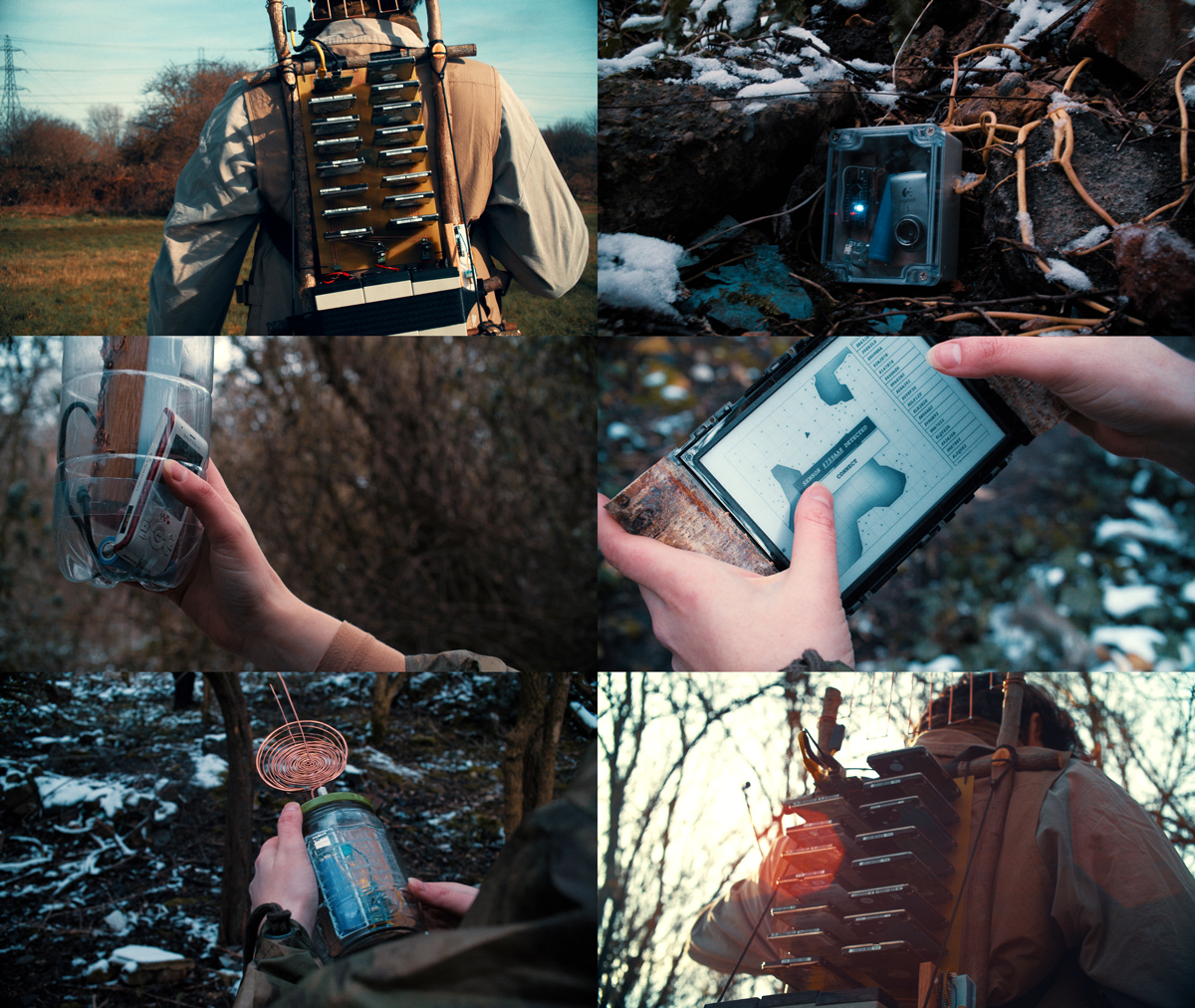 The artefacts as seen in the Intersection
The artefacts as seen in the Intersection
WEBSITE, VIEWING GUIDE, ENDINGS, BEGINNINGS
We would love for you to share the film and scan the resources we have assembled in the viewing guide.
We deserve more agency than simply opting in or out of technology. It is only by engaging with imaginative, visceral, future visions for technologies that are otherwise invisible, and out of sight by design and intent; that people will be able to understand their potential as well as their unintended consequences.
Our intention is that the knowledge acquired from engagement across public and private sectors will seed the direction for product development, investment, business strategies, policy and legislation formation, and legal regulation, as well as encourage wider public debate.
“We need to seize this moment. We need to build a future together. A future where our differences don’t divide us.”
– The Activist
We wanted to create a space on the internet that served as a junction for viewing the film and which sparked continued learning and discussion around themes explored throughout the film. You can also follow along on the Intersection’s Instagram and Twitter.
If the film resonates, we’d appreciate you sharing it widely – the more people that interact with the Intersection, the more meaningful the conversations will be.

THANKS
First and foremost, we want to thank our trusted partners Eshanthi Ranasinghe (now Director of Discovery & Insight, The Audacious Project at TED), Julia Solano (following her Fellowship at Omidyar, Julia is now Partner Program Manager at Armillaria) and Nicole Allred, Omidyar Network for commissioning such challenging work, and being supportive throughout the entire process, not to mention the difficulties of doing such work during COVID. They wrote a great piece about the project “The Intersection: Who’s in the Driver’s Seat — Us or Our Technology?”
We’d like to extend a thank you to our inspiring Advocates we worked with as we developed the concept for this film: Nialah Edari, Susanna and Scarlet Masius. To the brilliant people we interviewed during our foresight research, each bringing unique perspectives and expertise across technology, policy, data, privacy, democracy, power: Dragana Kaurin, Andrew Zolli, David Sangokoya, Shannon Mattern, Rachel Coldicutt, Anasuya Sengupta, Tim Maughan, Madeleine Elish. A huge thank you also to all our ethnographic research participants across the US, India, China and UK.
Thank you to our brilliant comrades who worked with us on the film: Tim Maughan for the screenplay and dialogue, David Leroy Thomas our lead director of photography, Dimitris Papadimitriou and Michele Vannoni for the visual effects; Sam Conran for the soundscape; Andreas Palfinger for graphic and motion design, Jay Owens for copywriting and Joss Alan Garnet-Lawson, Mark Stewart and Indre Srebaliute for the production assistance.
